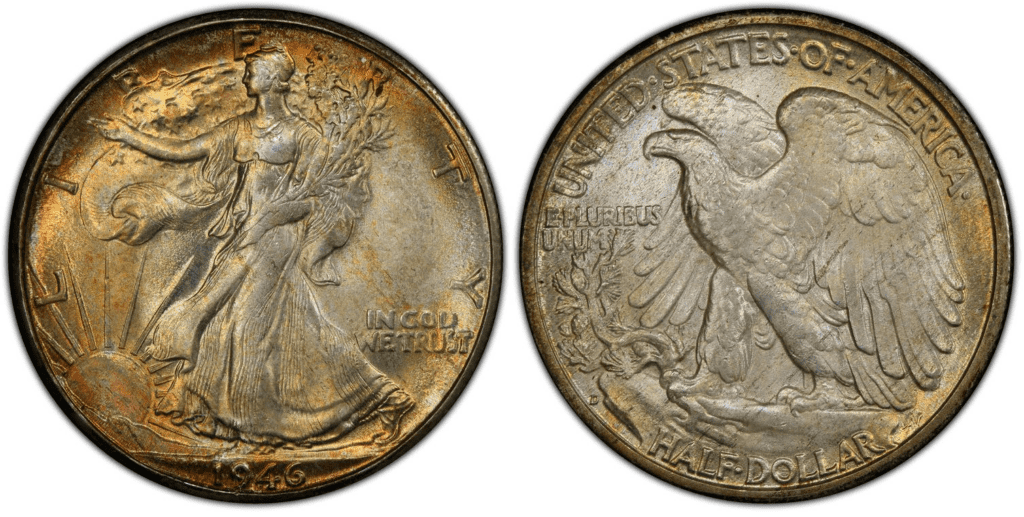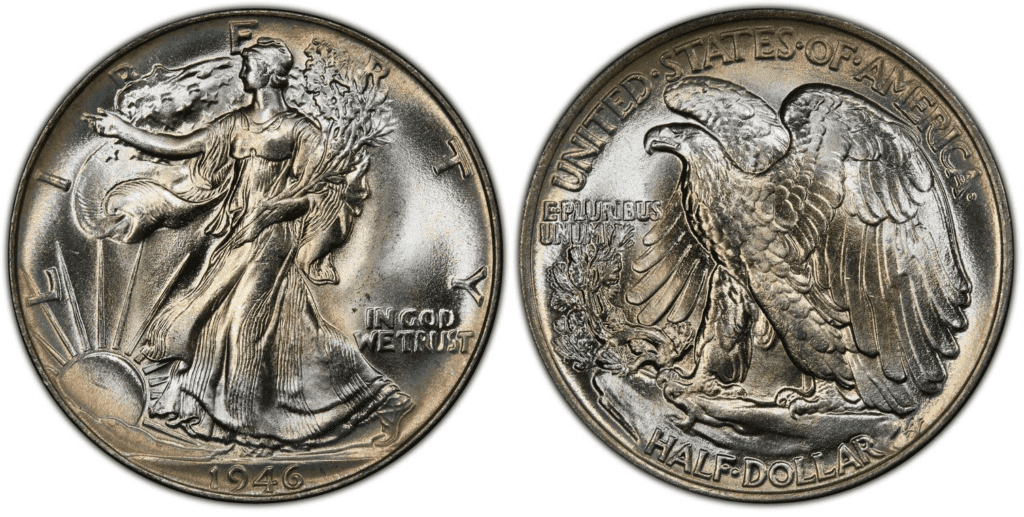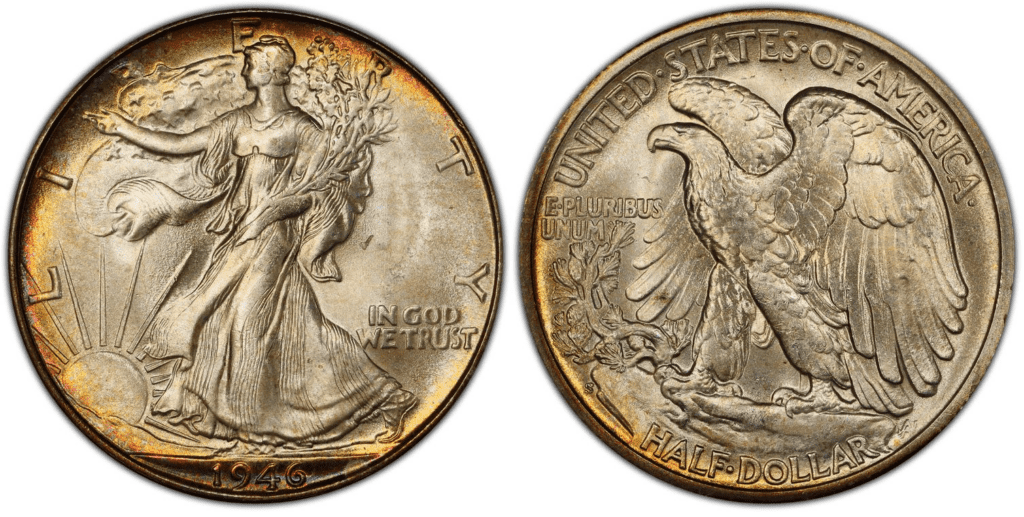What Is the 1946 Walking Liberty Half Dollar Made Of?
Are you having difficulty looking for coin guides, especially for the pennies made in the 1940s? No worries! This article guide discusses the more than 70-year-old coin made in history – the 1946 Walking Liberty half dollar value. You can learn more about its composition, history, varieties, price value, and more as you read on.
The 1946 Walking Liberty half dollar has a face value of 50-cent or half a dollar. The United States Mint issued the half-dollar coin for 31 years, from 1916 to 1947. The Mint produced over 17 million Walking Liberty fifty-cent pieces in 1946 alone.
The 1946 Walking Liberty fifty-cent composition is 90 percent pure silver and 10 percent copper. It has a reeded edge and includes the following specifications:
- Mass – 12.50 g
- Diameter – 30.63 mm
- Thickness – 1.8 mm
In 1915, Robert W. Woolley, the new Mint Director, decided to replace coin designs that had been used for 25 years. At that time, the Barber coinages struck in 1892; dimes, quarters, and half dollars were due for replacement.
So, Woolley instructed the Commission of Fine Arts to conduct a competition for the new coin design. The result announced that Adolph A. Weinman, a well-known sculptor, and engraver, was the winner of the competition. On February 28th, 1915, Weiman’s five sketches were selected. He was commissioned to design the dime, half dollar, and the quarter’s reverse.

The 1946 Walking Liberty half dollar obverse (heads) bears a full-length figure of Liberty facing left with one arm stretched (also to the left) and the other carrying branches of laurel and oak, symbolizing civil and military glory. In the background, it shows the folds of the Stars and Stripes of the American flag flying to the breeze and the sun unfolding the dawn of a new day.
You can also see the following inscriptions on the obverse side:
- LIBERTY
- IN GOD WE TRUST
- 1946 – at the feet of Liberty
On the other hand, the half dollar’s reverse (tail) features an eagle perched high upon a mountain crag — its wings unfolded with a fearless spirit. From a crack of a rock springs a sapling of mountain pine, symbolizing America.
The following inscriptions are also found on the reverse side:
- UNITED STATES OF AMERICA
- E PLURIBUS UNUM
- HALF DOLLAR
Weinman’s half-dollar design successfully went into production. However, it wasn’t struck very well; Franklin’s bust replaced it on the half dollar in 1948.
Many considered the artistic design of the fifty-cent piece to be among the most beautiful U.S. coins. During its centennial commemoration in 2016, the coin was issued in gold.
1946 Walking Liberty Half Dollar Varieties
1946 Walking Liberty Half Dollar was struck at the three mints in the U.S.: Denver, Philadelphia, and San Francisco mints. These mints produced more than 17 million half dollar coin varieties: 1946-D, 1946-P, and 1946-S. The economy in the U.S. slowed dramatically at the end of World War II, resulting in a cutback of coin production.
As the coins have not been produced for more than 50 years and were minted during the most iconic period of American history, many coin collectors find the half dollar to be sought after. Unfortunately, finding a variety of half a dollar in a preserved and good condition is not easy.
Let’s take a look at the descriptions of each of the three varieties below and details of the error coins that were produced:
1946 D Walking Liberty Half Dollar
Edge: Reeded
Mint Mark: D – at the lower left side of the reverse between the rim and the rock
Place of minting: Denver
Year of minting: 1946
Face Value: $0.50 (fifty cents)
Price: $40 to $70 (or more)
Quantity produced: 2,151,000
Designer: Adolph Alexander Weinman
Composition: 90% Silver, 10% Copper
Mass: 2.5 grams
Diameter: 30.63 mm
Thickness: 1.8 mm

photo source: PCGS
Among the issued coins in the 1940s, the 1946-D variety was the lowest mintage and hardest to find in circulated condition. For uncirculated condition, the 1946 Walking Liberty fifty-cent piece is the second most common versus the 1943 Philadelphia-minted Walking Liberty half dollar being more common.
1946 P Walking Liberty Half Dollar
Edge: Reeded
Mint Mark: No mint mark
Place of minting: Philadelphia
Year of minting: 1946
Face Value: $0.50 (fifty cents)
Price: $33 to $37 (or more)
Quantity produced: 12,118,000
Designer: Adolph Alexander Weinman
Composition: 90% Silver, 10% Copper
Mass: 2.5 grams
Diameter: 30.63 mm
Thickness: 1.8 mm

photo source: PCGS
For the Choice Uncirculated condition, the 1946 Philadelphia minted coin is the rarest among the Walking Liberty half dollars struck from 1941 to 1947. The 1947 series is a close second. When it comes to the strike conditions, the coins in Philadelphia didn’t have any issues. You can still see many coins having frost and luster.
1946 S Walking Liberty Half Dollar
Edge: Reeded
Mint Mark: S – at the lower left side of the reverse between the rim and the rock
Place of minting: Denver
Year of minting: 1946
Face Value: $0.50 (fifty cents)
Price: $32 to $54 (or more)
Quantity produced: 2,151,000
Designer: Adolph Alexander Weinman
Composition: 90% Silver, 10% Copper
Mass: 2.5 grams
Diameter: 30.63 mm
Thickness: 1.8 mm

photo source: PCGS
Having struck the most coins, the San Francisco Mint produced the most common Walking Liberty Half Dollar in the 1946 series. Coins in an Uncirculated condition are rare. However, you can still find many frosty 1946 Walking Liberty coins available.
List Of 1946 Walking Liberty Half Dollar Errors
Given the massive production of the 1946 Walking Liberty half-a-dollar coins, you could expect that there would be mint-error coins produced. When the equipment is overworked, it could deteriorate its performance, resulting in error coins. Human errors also contribute to these errors.
Despite these errors, the mint-error coins are known for their unique and distinct outcome. This makes it more interesting and attractive to many collectors as they can put a premium tag when offered in the market.
Different types of errors can occur during minting; these are but not limited to the following:
- Die crack
- Rotated die
- Doubled die
- Clipped planchet
- Bank planchet
- Weak strike
- Off-center strike
- Broadstrike
- Lamination error
One popular error for the 1946 Walking Liberty Half Dollar coin is the doubled die on the reverse side of the coin.

The error is mainly seen in “E PLURIBUS UNUM” and the Eagle’s right wing. This is noticeable even without magnification.
Usually, doubled die error (misspelling of double die) is visible to the human eye. When the die or hub misaligns during the hubbing process, it can create duplicate design elements. Doubled die strength varies from very light, isolated to extreme and widespread.
How Much Is 1946 Walking Liberty Half Dollar Worth Today?
The 1946 Walking Liberty half dollar coins have value as both numismatic and as silver bullion. As it is made of 90% silver and 10% copper, its melt value is based on the latest price of the market’s metals and the specifications.
At the current price, 1946 Walking Liberty half dollars have an approximate melting value of $8.7708. This melt value is calculated based on the current silver price per ounce.
You can find the different values of the 1946 walking Liberty fifty-cent in the chart below:
| Coin | Condition | Grade | Mintage | Value |
| 1946 D Walking Liberty Half Dollar | Circulated/Mint | Not graded | 2,151,000 | $13 to $32 |
| 1946 D Walking Liberty Half Dollar
|
Uncirculated/Mint | MS-66 | 2,151,000 | $165 to $360 |
| 1946 D Walking Liberty Half Dollar
|
Uncirculated/Mint | MS-67 | 2,151,000 | $720 to $1,500 |
| 1946 D Walking Liberty Half Dollar
|
Uncirculated/Mint | MS-68 | 2,151,000 | $3000 to $4,920 |
| 1946 P Walking Liberty Half Dollar | Circulated/Mint | Not graded | 12,118,000 | $13 to $20 |
| 1946 P Walking Liberty Half Dollar | Uncirculated/Mint | MS-66 | 12,118,000 | $125 to $558 |
| 1946 P Walking Liberty Half Dollar | Uncirculated/Mint | MS-67 | 12,118,000 | $705 to $2,280 |
| 1946 P Walking Liberty Half Dollar | Uncirculated/Mint | MS-68 | 12,118,000 | $14,950 to $18,950 |
| 1946 S Walking Liberty Half Dollar | Circulated/proof | Not graded | 3,724,000 | $13 to $25
|
| 1946 S Walking Liberty Half Dollar | Uncirculated/proof | MS-65 | 3,724,000 | $94 to $216 |
| 1946 S Walking Liberty Half Dollar | Uncirculated/proof | MS-66 | 3,724,000 | $192 to $305 |
| 1946 S Walking Liberty Half Dollar | Uncirculated/proof | MS-67 | 3,724,000 | $900 to $2,325 |
As you can see, the 1946 Walking Liberty 50-cent can be tremendously valuable. If you’re still not convinced, take a look at these auction records for each variety:
- $38,400 – a 1946-S 50C (Regular Strike) coin with a grade of MS67+ sold on June 2021 by Stack’s Bowers
- $31,200 – a 1946-D 50C (Regular Strike) coin with a grade of MS67+ sold on June 2021 by Stack’s Bowers
- $28,200 – a 1946 50C (Regular Strike) coin with a grade of MS67+ sold on January 2019 by Legend Rare Coin Auctions
How Does The Grading System Work?
The Sheldon Scale is used by numismatists to provide a numerical value to coins. The Sheldon Scale goes from poor (P-1) to perfect mint state (P-1) (MS-70). Coins were originally evaluated using words to reflect their condition (Good, Fair, Excellent, Etc.). Unfortunately, coin collectors and dealers had different ideas about what each of these terms represent.
Professional numismatists joined together in the 1970s and established CoinGrading standards. These numismatists now assign grades at key places on the seventy-point scale, using the most regularly utilized numeric points in conjunction with the original adjective grade. The following are the most common coin grades:
-
-
- (P-1) Poor – Indistinguishable and probably damaged; if used, must have a date and mintmark; otherwise, rather battered.
- (FR-2) Fair – Nearly smooth, but without the damage that a coin graded Poor often possesses. The coin must have enough detail to be identified.
- (G-4) Fair – Inscriptions have merged into the rims in some areas, and important elements have been mostly erased.
- (VG-8) Very Good- A little weathered, but all of the primary design elements are visible, albeit faintly. There is little if any, central detail left.
- (F-12) Good – The item is very worn, yet the wear is even, and the overall design details stand out clearly. Rims are almost completely isolated from the field.
- (VF-20) Very Fine – Moderately weathered, with some finer features still visible. The motto or all letters of LIBERTY are readable. Both sides of the coin have entire rims that are separated from the field.
- (EF-40) Extremely Fine – Gently used; all gadgets are visible, and the most important ones are bold. The finer details are bold and clear, however, light wear may be seen.
- (AU-50) Uncirculated – Slight evidence of wear on the coin’s design’s high points; may have contact marks; eye appeal should be adequate.
- (AU-58) Uncirculated Choice – Slight traces of wear, no severe contact marks, almost full mint shine, and great eye appeal.
- (MS-60) Mint State Basal – Strictly uncirculated; no indication of wear on the coin’s highest points, but an unsightly coin with reduced luster, visible contact marks, hairlines, and other flaws.
- (MS-63) Mint State Acceptable – Uncirculated, but with contact scratches and nicks, little reduced shine, but otherwise appealing appearance. The strike is weak to average.
- (MS-65) Mint State Choice – Uncirculated with great mint shine, very little contact blemishes, and exceptional eye appeal. The strike is unusually severe.
- (MS-68) Mint State Premium Quality – Uncirculated with superb luster, no obvious contact marks to the naked eye, and exceptional eye appeal. The strike is quick and appealing.
- (MS-69) Almost Perfect Mint State – Uncirculated with perfect brilliance, a sharp and appealing strike, and extremely good eye appeal. A near-perfect coin with minor imperfections in the planchet, strike, and contact markings (seen only under 8x magnification).
- (MS-70) Mint State Perfect – Under 8x magnification, there are no tiny imperfections discernible; the strike is crisp, and the coin is perfectly centered on a beautiful planchet. Rarely seen on a coin, this coin is bright and whole, with original luster and exceptional eye appeal.
-
Where To Buy Or Sell 1946 Walking Liberty Half Dollar?
This is easy! You can visit online to find the 1946 Walking Liberty Half Dollar pieces. Online stores like eBay, Etsy, and Amazon offer these coins. You can also register on these sites to sell your collections.
If you are to sell, the price of the 1946 Walking Liberty Half Dollars generally depends on the quality, condition, and rarity. So ensure to have your collections graded before putting them on sale.
If you prefer physical stores, you can buy or offer rare coins, like the 1946 Walking Liberty fifty cents, to pawn shops or antique stores. Coin shops and auction houses can also be your options.
Professionals from PCGS and NGC can also help if you need advice on how and where to go about buying or selling your 1946 half-dollar coins.
FAQs
How much is a 1946 Walking Liberty Half Dollar Worth?
In circulated condition, a 1946 Walking Liberty Half Dollar can be worth between $11.75 and $32.50. But in pristine and uncirculated condition, a 1946 Half Dollars can be sold for as much as $19,000 in an open market. This price value is based on the latest price guide of NGC.
Where is the mint mark on a 1946 Walking Liberty half dollar?
You can find the “D” and “S” mint marks of the 1946 Walking Liberty half dollars at the lower left of the reverse (tail) side, which is between the edge of the rim and the rock.
Is a 1946 Walking Liberty half dollar real silver?
The 1946 Walking Liberty Half Dollar is made of 90% pure silver and 10% copper.



